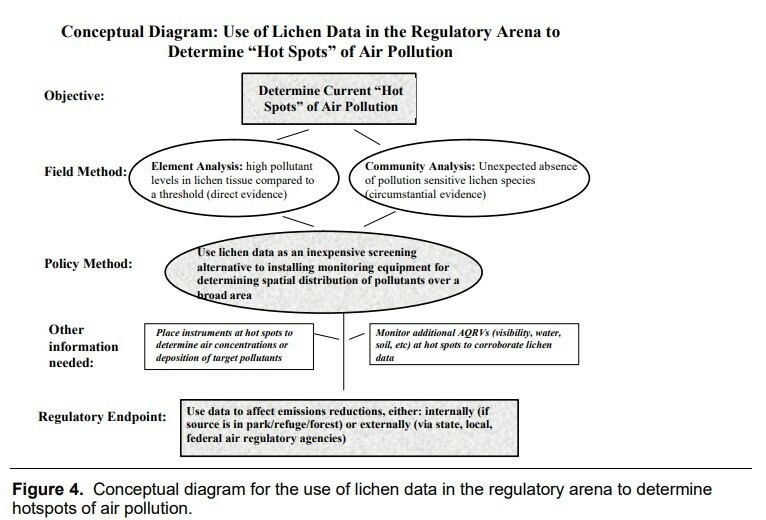__
# Background
Lichen are not plants, but rather a symbiotic relationship between fungi and algae and/or cyanobacteria. Macrolichen (leafy or bushy lichen) that grow on trees obtain all their nutrients from the surrounding air, moisture, and rain, which means that they also absorb many of the chemicals and pollutants present in the air and can serve as mini living air quality monitors, or [bioindicators](https://publiclab.org/wiki/bioindicators). You can learn more about lichen and their main functional groups in this [research note](https://publiclab.org/notes/fongvania/07-21-2021/learning-to-spot-lichens-and-mosses)
This page will hopefully be helpful to folks at various stages in the air quality study design process. Anyone just starting to design an air quality study or reassessing an ongoing study can use this wiki to assess whether bioindicators can and should be integrated into the study.
## Use Cases and Limitations
### Use Cases
There are many benefits to using lichen to assess air quality compared to traditional instrumentation. Namely, biomonitoring with lichens tends to be _lower cost_ than installing monitoring instruments or collecting samples, and there is a _database of baseline "clean" lichen community composition_ in Forest Service plots for comparison. Furthermore, lichen have a _wide geographic range_ and can monitor air quality in locations not amenable to sensors or equipment, making them suitable for assessing relative air quality in a region.
### Limitations and Considerations
However, you should be aware of the limitations and considerations of using lichens for air quality biomonitoring. As with all bioindicators, lichen composition and health are influenced by factors other than the parameter of interest, which in this case is air quality, so other environmental variables such as temperature, relative humidity, available substrates, elevation, and precipitation need to be collected and used to isolate the pollution signal. In other words, _multivariate analysis is often required_.
In addition, while academic research on this topic is abundant, to our knowledge, there is _no known precedent_ for a large-scale US community science project using lichen as air quality bioindicators, and US _regulatory agencies are often unfamiliar with lichen monitoring data_. Thus, it is critical to clearly communicate monitoring design and/or to convert lichen data into pollutant concentration units familiar to regulators through co-location with instrumented monitors and calibration.
Currently, lichen are most useful as low-cost screening tools to identify pollution hotspots and prioritize placement of more expensive equipment.
[](/i/46866?s=o)
Source: [US Forest Service, Air Pollution-Related Lichen Monitoring in National Parks, Forests, and Refuges: Guidelines for Studies Intended for Regulatory and Management Purposes (2003)](http://npshistory.com/publications/air-quality/lichen-studies.pdf)
# Methods
##Categories of Methods
||Elemental Analysis|Community Analysis|Physiological Assessment|Transplant Study|
|------|------|------|------|------|
|**Description** |Collect lichen samples for laboratory analysis to determine identifies and concentrations of elements of interest|Collect and compare information on richness, abundance, and presence/absence of indicator species over geographic space or time.| Analyze changes in lichen anatomy and photosynthetic ability of naturally occurring lichen or transplanted specimens in response to exposure to pollutants. Examples of parameters to measure include chlorophyll concentrations, chlorophyll fluorescence, cell membrane integrity, CO2 exchange capacity.|Transplanting healthy lichen to a test area and measuring physiological response and/or elemental accumulation.|
|**Expertise Required**|Lichen Identification, Laboratory Analysis, Results interpretation|Lichen Identification|Lichen Identification|Lichen Collection and Transplantation|
|**Equipment**|Hand lens, Special laboratory-grade collection bags | Hand lens | Varies, but can include:
- Spectrometer
- IR camera
- Regular camera
- Nail polish remover
|Artificial substrates such as plastic air filters and burlap|
|**Cost**|Lab testing cost varies; $50-$250 per sample depending on processing steps required and elements to test for. Laboratory-grade specimen bags can be expensive|||
|**Considerations**|Lab turnaround times can take 6-12 months|||
##Specific Methods
**Community Analysis**
**Physiological Assessment**
**Elemental Analysis**
##Other Guidance for Study Design
**Determining Lichen Species of Interest**
**Spatial Sampling**
**Converting Observations to Air Quality Indicators**
**Consulting Experts**
## Questions
[questions:lichen]
## Research notes
[notes:lichen]
## Wikis
[wikis:lichen]
## Activities
[activities:lichen]
#Resources
**Hands-On Learning**